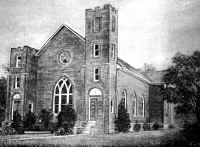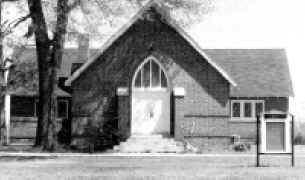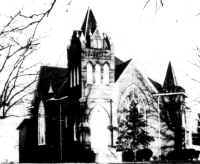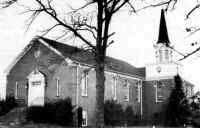 |
|||||||||||||||
 |
It is quite possible that the origins of the Lutheran Church in Stanley came from the Old Whitehaven
Church which began in what is now Lucia. The church was begun by Rev. Robert Johnston Miller, an
Episcopalian minister. Since there were no other ministers within hundreds of miles in the 1700's,
people of different faiths congregated at Old Whitehaven for worship. The majority, Lutherans, urged
Rev. Miller to accept ordination into the Lutheran Church, which he did.
First United Methodist ChurchBy: Joyce J. Handsel
The Stanley United Methodist Church dates back to 1815, when the Providence Methodist Episcopal
Church was established near Dutchman's Creek midway between Stanley and Mt. Holly. It is believed
that in the first years the Providence Church was merely a brush arbor, but later a "meeting house"
was built.
Bruington Memorial Church
By: Ruby Morris Markland |
||||||||||||||

|
Built around 1924 |
One of the first missionaries sent from N. C. Baptist State Mission Board to this area was Rev.
Robert Bruington Jones. A church was organized on Saturday, October 29, 1853.
The church that was organized by Rev. Bruington Jones, once stood at a hill west of the old road to
Mt. Holly. The first church roll was made of of thirty eight people. Of those listed as members
twenty three were white and fifteen were black.
After the Civil War, churches were started by the black people. Many people went west. The roll,
that at one time had listed 417 names, now had only 76. The land around the church had been bought
and fenced making it difficult to get to the church.
In 1872 a conference was called to discuss what could be done. They voted to move the church to the
spot where Hickory Grove now stands. Even though 50 of the 76 present voted to move the church,
twenty-six refused to go with them. So the new location, that was to be Bruington was given a new
name, Hickory Grove. In June 1872, the Pastor, George Fite, leader of those left behind, took 13
members and formed Fellowship Baptist Church in Belmont. In July 1872, again a conference was called
of the 13 left. Only eight were present. Pastor Will Upton and Jack and Billy Hansel voted to
disband. Five women "rose up" and said that they were not going to give up. They could do something.
The majority voted to move to another location. The old church building was torn down and moved to
the triangle made by Old Mount Holly and Morris Farm Roads. Another log building was added, and for
their summer services a brush arbor was built. Regular services were held and many additions were
made.
Hickory Grove's history seemed to see the hand of God in all of this. Their comment was: "The old
church then became three active churches."
By 1883 the Rev. John F. Morris was serving Bruington Baptist Church as well as Hickory Grove. They
began to see the need for a better location and a larger building. About June of
1885, they decided
to move to Brevard Station, as Stanley was then called. A two acre lot was purchased.
The new church was built and dedication services were held on May 31, 1891.
In November of 1965 the church voted to relocated to ten acres owned by Mr. & Mrs. S. O. Brandon, to
almost the exact spot where the church began in 1853. The first service was held in the new church
building in March of 1970.
Recognizing that the church was the first Baptist church in Stanley, and realizing that there are
three other Baptist churches in town, the church voted to change the name to First Baptist in
September of 1969.
![]()
Springfield Memorial Baptist Church
By: Mrs. A. B. Brooks, Church Historian

|
1928 to 1985 |
Blacks and whites worshiped together at Bruington Baptist Church (a white organization) located
between Stanley and Mt. Holly. There were 25 members, 13 whites and 12 blacks.
As time passed, people living near the church built a fence that made it difficult for members to
get to church. Because of this, Bruington Baptist Church disassembled somewhat. The 12 black members
organized Galilee Baptist Church located on Hickory Grove Road in 1863. The members elected Rev.
Tom Barnwell as the first pastor of the church.
Several years later Galilee Baptist Church was destroyed by fire. On September 18, 1874 Rufus and
Susan Friday stepped in and decided to do something for their fellow man; they donated land for a new
church to be built upon.
During the pastorate of Rev. Burton a log structure was built. The church was named after the Rev.
Burton's hometown of Springfield, West Virginia.
In 1908, Rev. R. D. Harris accepted the church pastorate and served for 21 years. Under his leadership
the church progressed spiritually, financially and physically. The members wanted to glorify God by
providing better facilities. After an enormous amount of work and sacrifice, the church was completed.
On 14 January 1928 the Gastonia Gazette reported: "Thursday evening was a great event with the
members of Springfield Baptist Church when they opened their newly erected brick church which cost
approximately $10,000. When the doors opened they walked in with the church free from indebtedness."
In 1982, plans to build a new sanctuary were finalized. On November 11, 1984, Rev. Theodore Armstrong
Jr. led the Litany as ground was broken for the sanctuary. The new sanctuary is the second phase of a
building program which also included enlarging and completely renovating the fellowship hall,
additional classrooms, and a library. The project was complete August 18, 1985 in time for dedication
services.
![]()
First Presbyterian Church
By: Alfred M. Rhyne

|
Built in 1928 |
Before 1891 there was no Presbyterian Church close by to the Stanley area. The nearest churches were
Castanea at Lucia, Ironton at Iron Station and Goshen at North Belmont. There were no paved roads at
this time so travel to and from a church by horseback and buggy was rather rough, especially in
winter months with the cold and mud.
Due to the above reasons, Presbyterians in our area petitioned the Mecklenburg Presbytery to organize
a Presbyterian church in Stanley. On November 27, 1891 the Mecklenburg Presbytery met in Stanley
Lutheran Church to consider the petition to organize a church in Stanley. Ten members (with baptized
children) from the Goshen Church, five members from Castanea Grove Church and one member from
Ironton church presented their certificates to be members of the new church. The first services were
conducted January 3, 1892 by Rev. William E. McElwaine and were held in the Lutheran Church.
During the years of 1892 and early 1893 the first church was built. Much of the labor and materials
were donated. The first meeting for services in the new building was held February 5, 1893.
![]()
Other churches in Stanley include:
Mount Pleasant United Methodist Church founded in 1898; Alexis Baptist Church, organized in 1903 from Mt. Zion Baptist Church; The Stanley Pentecostal Holiness Church which began holding meetings in the 1930's; Community Pentecostal Holiness Church founded in 1966; New Life Baptist Church which started as a mission from Bruington Memorial Baptist Church in 1959; Stanley Church of God, organized in 1949; The Christian Brethren Church pastored from 1923 until 1969 by the Rev. William McCulloch; and Craig Memorial Baptist Church.
Complete details on all churches are listed in the book,
"Echoes and Shadows of Two Centuries"



